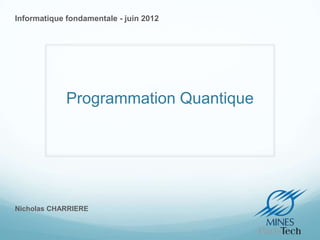Programmation quantique
•Transferir como PPTX, PDF•
4 gostaram•6,703 visualizações
courte présentation de l'informatique et de la programmation quantique
Denunciar
Compartilhar
Denunciar
Compartilhar

Recomendados
Recomendados
Mais conteúdo relacionado
Destaque
Destaque (20)
Product Design Trends in 2024 | Teenage Engineerings

Product Design Trends in 2024 | Teenage Engineerings
How Race, Age and Gender Shape Attitudes Towards Mental Health

How Race, Age and Gender Shape Attitudes Towards Mental Health
AI Trends in Creative Operations 2024 by Artwork Flow.pdf

AI Trends in Creative Operations 2024 by Artwork Flow.pdf
Content Methodology: A Best Practices Report (Webinar)

Content Methodology: A Best Practices Report (Webinar)
How to Prepare For a Successful Job Search for 2024

How to Prepare For a Successful Job Search for 2024
Social Media Marketing Trends 2024 // The Global Indie Insights

Social Media Marketing Trends 2024 // The Global Indie Insights
Trends In Paid Search: Navigating The Digital Landscape In 2024

Trends In Paid Search: Navigating The Digital Landscape In 2024
5 Public speaking tips from TED - Visualized summary

5 Public speaking tips from TED - Visualized summary
Google's Just Not That Into You: Understanding Core Updates & Search Intent

Google's Just Not That Into You: Understanding Core Updates & Search Intent
The six step guide to practical project management

The six step guide to practical project management
Beginners Guide to TikTok for Search - Rachel Pearson - We are Tilt __ Bright...

Beginners Guide to TikTok for Search - Rachel Pearson - We are Tilt __ Bright...
Programmation quantique
- 1. Informatique fondamentale - juin 2012 Programmation Quantique Nicholas CHARRIERE
- 2. Les origines Une recherche incessante d’optimisation des calculs La théorie de l’ordinateur quantique La possibilité de combiner les propriétés fortes de la mécanique quantique, au calcul appliqué Un domaine qui reste très théorique, vu l’absence d’ordinateur fictif Opposition quantique / éléctricité
- 3. Comment définir la programmation quantique Un ensemble de langages de programmation quantiques… Qui permettent l’implémentation d’algorithmes quantiques Utilisant des qubits, et fonctionnant sur des ordinateurs quantiques Qui supplanteraient les machines de Turing en puissance
- 4. Phénomènes quantiques utiles L’intrication quantique : l’état quantique de deux éléments doit être décrit globalement, malgré une séparation physique possible des objets La superposition : on décrit la position d’une particule comme une CL infinie de vecteurs probabilités de présence dans différents endroits On ne se base plus sur des bits, mais sur des qubits
- 5. Les qubits Qubit = quantum + bit : plus petite unité de stockage en informatique quantique Composé d’une superposition des deux états de base (brakets) État A.|0> + B.|1> , et la norme au carré de A et B donnent les probabilités de mesurer les états Duplication impossible cryptographie La mesure de l’état renvoie (1,0) ou (0,1)… …mais on peut transporter l’information grâce à la téléportation quantique Représentation : spin, niveau d’énergie, polarisation d’un photon
- 6. Intérêt Puissance d’un ordinateur quantique est exponentielle par rapport au nombre de qubits Avec n qubits 2n états possibles On fait un calcul parallèle sur ces 2n états !
- 7. Langages de programmation quantique Ils sont nombreux, très étudiés dans la recherche Permettent de manipuler les qubits, et faire des opérations Exemples : Q (orienté objet) qGCL (quantum guarded command language) QFC QML
- 8. Quantum Computing Language (QCL) Le langage le plus connu, un des premiers, et sa syntaxe ressemble au C Possibilité de combiner du langage quantique et classique dans le même code source Type de donnée de base: qureg (registre de qubits)
- 9. QCL (2) Avec une librairie qulib, on peut observer l’état : Mais surtout, on peut définir des fonctions :
